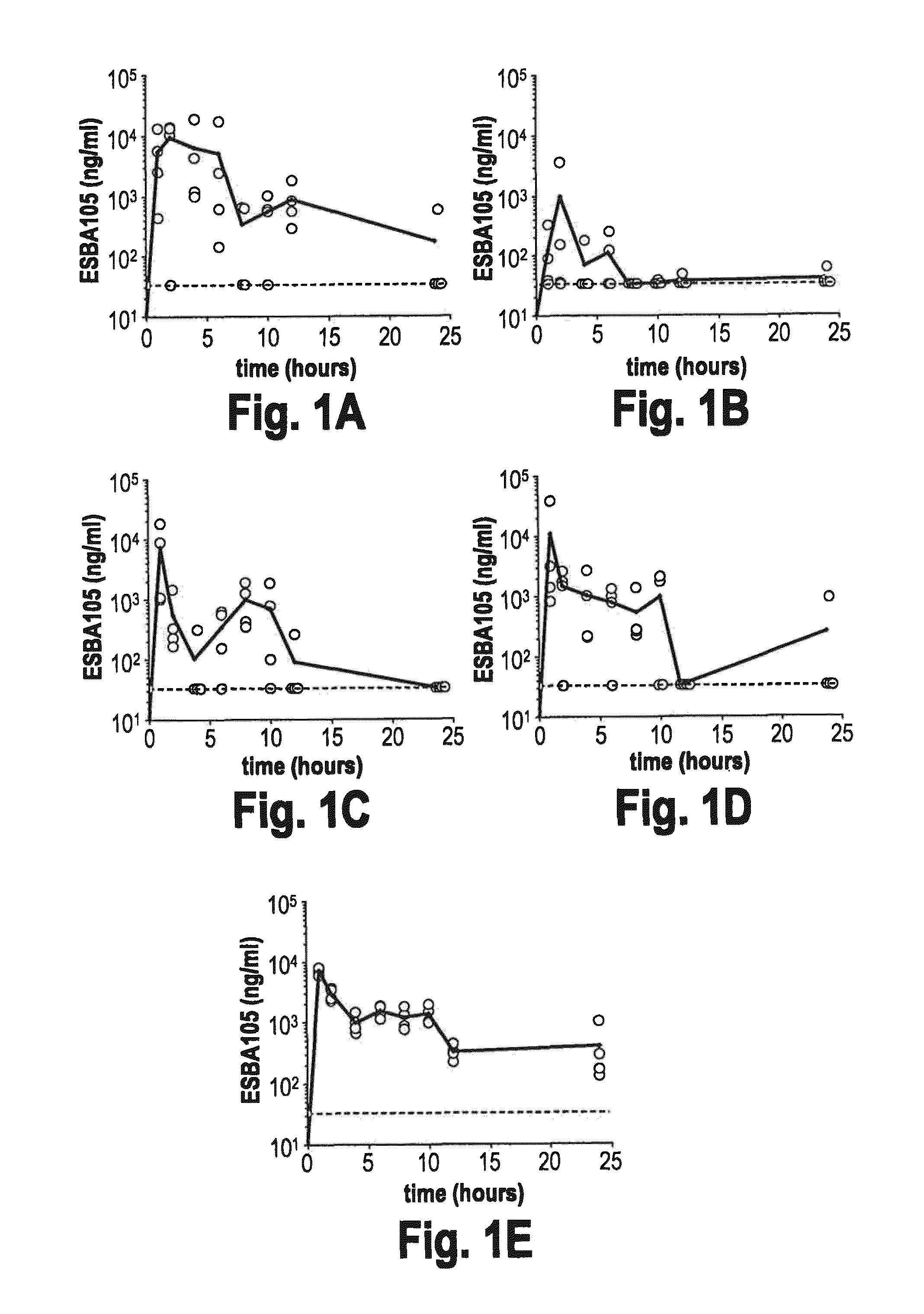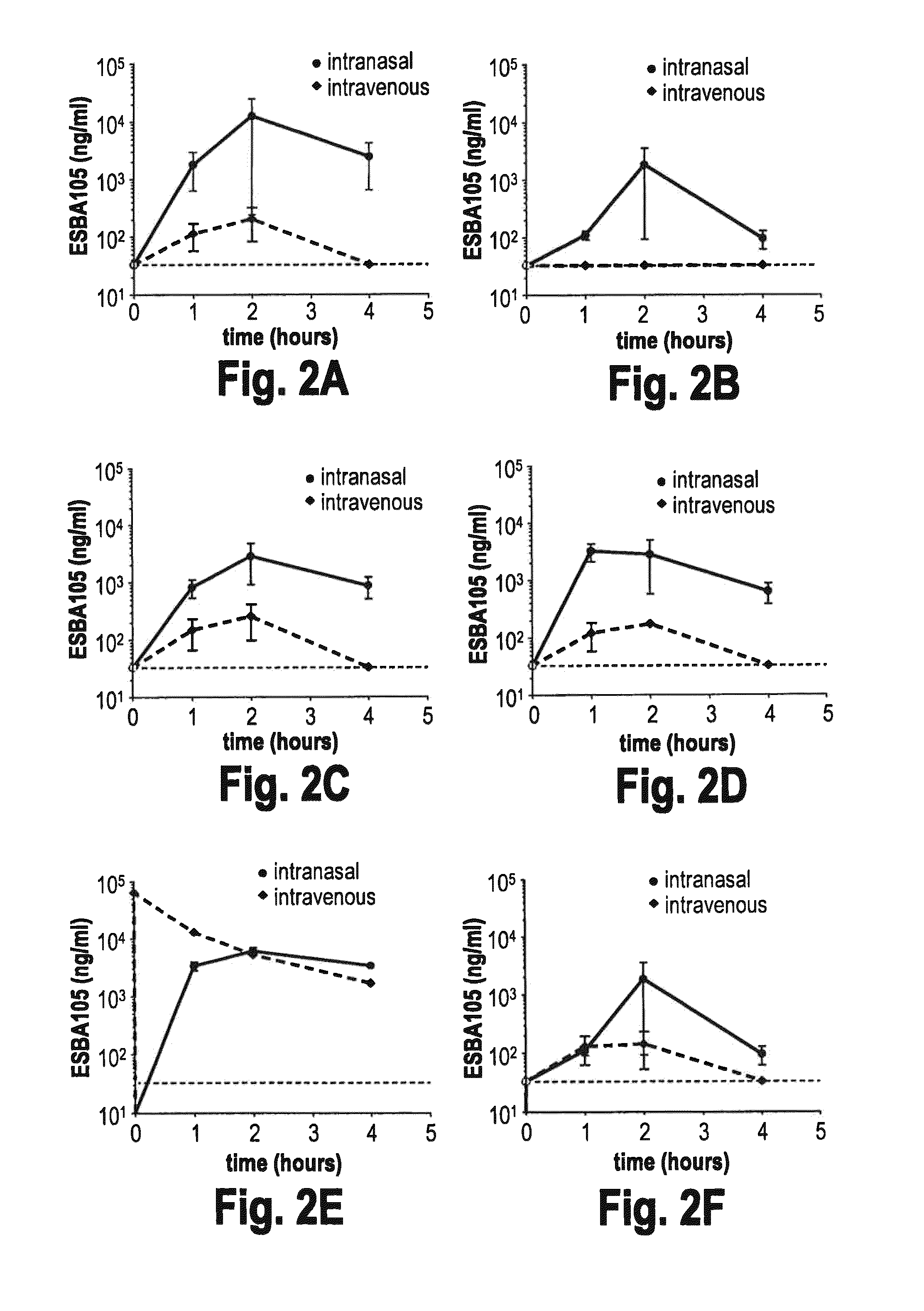Methods and compositions for enhanced delivery of macromolecules
a macromolecule and macromolecule technology, applied in the direction of antibody medical ingredients, bulk chemical production, peptide/protein ingredients, etc., can solve the problems of affecting the delivery of therapeutic antigen-binding peptide presently no convenient and efficient method for the delivery of therapeutic antigen-binding polypeptides into the cns, and hampered treatment of neurological disorders using such antigen-binding peptides. achieve the effect o
- Summary
- Abstract
- Description
- Claims
- Application Information
AI Technical Summary
Benefits of technology
Problems solved by technology
Method used
Image
Examples
example 1
Mode of Intranasal Administration
[0077]This example demonstrates that low volume nasal administration results in specific delivery to the CNS. For efficient and specific drug delivery into the CNS, an applied substance should remain in the nasal cavity; however, several studies have shown that an intranasally applied substance may migrate to the respiratory system and the gastrointestinal tract due to breathing and ingestion (Eyles et al. (1999) Int J Pharm 189, 75-79; Klavinskis et al. (1999) J Immunol 162, 254-262; Lundholm et al. (1999) Vaccine 17, 2036-2042; Trolle et al. (2000) Vaccine 18, 2991-2998). One of skill in the art will appreciate that a number of aspects (e.g. anesthesia, animal position, and volume and frequency of administration) may influence the residence time of the administered compound in the nasal cavity. Using the intranasal administration protocol described above, Evans Blue was used as a tracer to assess the post-administration distribution of the dye afte...
example 2
Delivery of ESBA105 to the CNS
[0078]This example demonstrates that intranasal administration of a scFv results in delivery of the scFv to the CNS. ESBA105 (SEQ ID NO: 1) is a single chain antibody that specifically binds and inhibits TNFalpha (see e.g. WO 06 / 131013, which is hereby incorporated by reference). Following intranasal administration by the above described protocol, ESBA105 reached significant concentrations in all regions of the brain analyzed, and displayed a bimodal distribution over time. Maximum ESBA105 concentrations (Cmax) in cerebellum and brainstem were reached one hour after the first instillation, with concentrations in the olfactory bulb and cerebrum peaking one hour later. ESBA105 levels then declined in all brain regions, but rose again after 6-12 hours to produce a clear second, lower level, concentration peak in the olfactory bulb, cerebellum, and brainstem (FIG. 1), which demonstrates that two different migration routes are likely to exist. Highest concen...
example 3
ESBA105 Delivery to the CNS is Direct
[0079]This example demonstrates that intranasal administration of ESBA105 results in direct delivery to the CNS, rather than via the bloodstream. To determine whether ESBA105 migrates directly through the BBB to the CNS from the nasal cavity, or indirectly via systemic absorption and subsequent trans-BBB delivery to the brain, intranasal administration was compared side by side with intravenous injection as described above. Following intravenous injection, considerable concentrations of ESBA105 were reached in all analyzed regions, except the cerebrum where concentrations were below the lower limit of quantitation. However, considerably higher drug concentrations were measured in all brain regions following intranasal administration (FIG. 2). Maximum ESBA105 levels in cerebellum and brainstem upon intranasal dosing were about 10-18 fold higher than those following intravenous injection. Moreover, Cmax in the olfactory bulb was more than 60-fold h...
PUM
| Property | Measurement | Unit |
|---|---|---|
| concentrations | aaaaa | aaaaa |
| concentrations | aaaaa | aaaaa |
| particle size | aaaaa | aaaaa |
Abstract
Description
Claims
Application Information
 Login to View More
Login to View More - R&D
- Intellectual Property
- Life Sciences
- Materials
- Tech Scout
- Unparalleled Data Quality
- Higher Quality Content
- 60% Fewer Hallucinations
Browse by: Latest US Patents, China's latest patents, Technical Efficacy Thesaurus, Application Domain, Technology Topic, Popular Technical Reports.
© 2025 PatSnap. All rights reserved.Legal|Privacy policy|Modern Slavery Act Transparency Statement|Sitemap|About US| Contact US: help@patsnap.com



